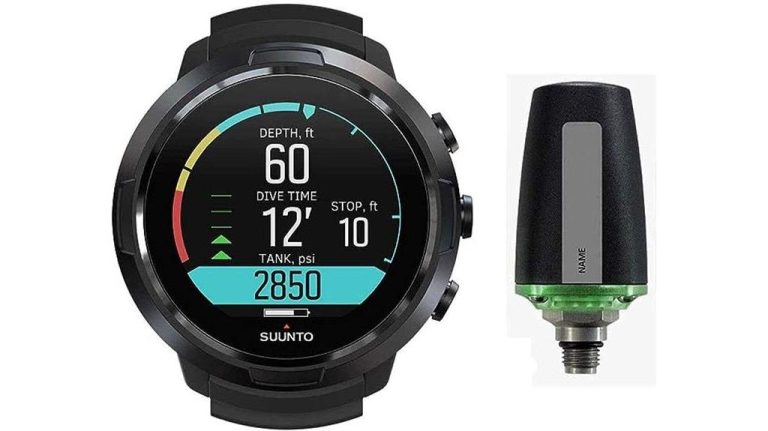Are you ready to take the plunge into the world of scuba diving? Look no further than the Suunto D5 dive computer. We’ve got all the details on this user-friendly and reliable device.
From its customizable modes to its accurate dive computations, the Suunto D5 is designed to enhance your diving experience. With its water resistance and wireless connectivity, this dive computer is built for the rigors of underwater exploration.
Join us as we explore the pros and cons of the Suunto D5.
Table of Contents
Key Takeaways
- Suunto D5 dive computer is designed to be clear and easy-to-use with multiple modes.
- Some users have experienced issues with scratched watch faces and pre-logged dives on new watches.
- There have been difficulties in turning off the watch and charging it before diving, as well as error messages and lack of instructions for resetting the watch.
- Users have found the display of the gas gauge and lack of easy access to air pressure, compass, and depth on the same screen inconvenient. Additionally, the strap length for wetsuit has been reported as short.
Key Features
One of the key features of the Suunto D5 dive computer is its ability to connect wirelessly to the Suunto app for data sharing. This feature allows users to easily transfer their dive data to their smartphones or tablets, providing a convenient way to track and analyze their diving activities.
With the Suunto app, divers can access detailed dive logs, including information on depth, time, temperature, and more. The app also offers features such as dive planning and the ability to share dive logs with friends and fellow divers.
This wireless connectivity enhances the overall user experience and provides a seamless way to monitor and review diving data, catering to the needs of divers who desire liberation and convenience in their diving adventures.
Detailed Features
We found that the Suunto D5 dive computer offers multiple modes and uses Suunto’s Fused RGBM2 algorithm for dive computations. This algorithm ensures accurate and reliable dive calculations, giving divers the confidence they need underwater.
The D5’s sleek design and easy-to-use interface make it a popular choice among divers looking for a user-friendly dive computer. It’s water resistant up to 100 meters, making it suitable for most diving activities. The wireless connectivity to the Suunto app allows for seamless data sharing and access to dive logs.
However, some users have reported issues with scratched watch faces and pre-logged dives on new watches. Additionally, there have been complaints about difficulties in turning off the watch and charging before diving, as well as error messages and lack of instructions for resetting the watch.
Pros and Cons
After testing the Suunto D5, our team found that the easy setup and automatic logging feature received positive feedback from users. The simplicity of the setup process allows divers to quickly get started with their dives, while the automatic logging feature eliminates the need for manual entry of dive data. This convenience enhances the overall diving experience and saves time for divers who want to focus on exploring the underwater world.
Additionally, the Suunto D5’s advanced algorithm, the Fused RGBM2, ensures accurate and reliable dive computations, providing divers with crucial information for a safe and enjoyable dive.
However, it’s important to note that some users have reported issues such as scratched watch faces and pre-logged dives on new watches. Furthermore, difficulties with turning off the watch and charging before diving have been reported. These factors should be considered when making a purchasing decision.
Concluding Thoughts
Overall, our team found the Suunto D5 to be a reliable and user-friendly dive watch, despite some reported issues with the watch face and pre-logged dives. While the scratched watch face and pre-logged dives on a supposedly new watch were certainly a concern, we believe that these issues can be addressed and resolved by Suunto.
The difficulties in turning off the watch and charging before diving can be frustrating, but once you get the hang of it, the functionality and usability of the watch make up for it. The error messages and lack of instructions for resetting the watch are certainly areas for improvement. Additionally, the inconvenient display of the gas gauge and lack of easy access to air pressure, compass, and depth on the same screen can be a drawback for some divers. However, the short strap length for wetsuit can be a dealbreaker for those with larger wrists.
Despite these setbacks, the positive feedback on the easy setup, automatic logging, and access to dive logs through the Suunto app is a major plus. The Suunto D5 dive computer is a solid choice for divers who value reliability and ease of use.
Frequently Asked Questions
How Long Does the Battery of the Suunto D5 Dive Computer Last?
The battery life of the Suunto D5 dive computer is approximately 6-12 hours, depending on usage. We found it to be sufficient for multiple dives in a day, but recommend charging it overnight.
Can the Suunto D5 Dive Computer Be Used for Technical Diving?
Yes, the Suunto D5 dive computer can be used for technical diving. It has modes like Nitrox and Gauge that cater to technical divers. Its Fused RGBM2 algorithm ensures accurate dive computations.
Does the Suunto D5 Dive Computer Have a Built-In Compass?
Yes, the Suunto D5 dive computer does have a built-in compass. It provides divers with the convenience of easily accessing their compass readings directly on the screen, enhancing their navigation capabilities underwater.
Is the Strap of the Suunto D5 Dive Computer Replaceable?
Yes, the strap of the Suunto D5 dive computer is replaceable. It provides flexibility for customization and ensures a comfortable fit for divers of various wrist sizes and preferences.
Can the Suunto D5 Dive Computer Be Used for Diving in Cold Water?
Yes, the Suunto D5 dive computer can be used for diving in cold water. It is water resistant to 100 meters and designed for various modes, including Nitrox.

